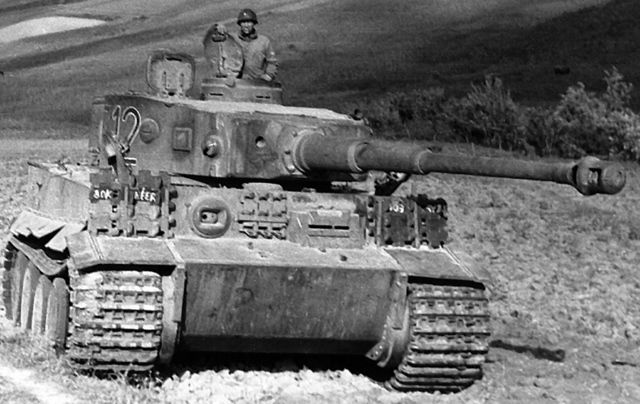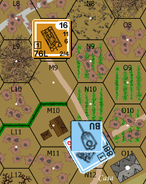Desperate Times
One of the things lost in the Cold War mayhem of ASL game design was tank ramming. I have heard it argued that ramming didn't really occur very often, but this argument is undermined by a 1996 article from Marshal of the Soviet Union Oleg Losik in Military Knowledge, for most Western observers a rather secondary journal for military writers.
But Losik is not a slouch. He worked his way up from draftee to Marshal of the Soviet Union, winning a Hero of the Soviet Union along the way. He attended officer's training at the Saratov Armored School in 1938 and acted as a platoon commander in the Winter War. To be sure, these were times of rapid advancement for new officers in the Red Army devastated by the purges. But most of the chaff was dismissed by 1943 and Losik kept going, being among the first to liberate Minsk. He wan an Order of Lenin and Gold Star along the way, leading an independent armor brigade.
So this is a guy who knows what he is talking about.
And he says ramming happened. Not just on a small scale, but frequently. Losik says that this tactic was used, according to his sources, about fifty times at Kursk alone.
I'm inclined to believe Losik, who was there and said it happened, rather than Glantz, a military historian with a US military background who says it didn't. Even though we know it did--even on the Western Front. And we have photographic evidence of it.
So, if for a moment you can concede that it happened, what are the battlefield conditions that allowed it to happen? For example, KV1's had a tendency to simply role over things. This was partially because they were invulnerable to many of the German anti-tank weapons of the day and behaved rather like a bull bothered by biting flies. It was also because the optics in the tank were frequently so bad that they had a difficult time hitting anything. So rather than stop and try to aim at a 37mm anti-tank gun, they would simply put front to enemy and roll it over. Tanks is probably a lot more irregular.
When a tank rams a tank, it requires desperation, bravery and a calculated risk Most of the Soviet cases named by Losik were cases where the ramming tank faced long odds and frequently were without a main armament that could hurt the ramee. In most of the cases Losik cited the drivers and commanders receive a (frequently posthumous) medal for doing so. That is, the situation called for an act of sacrifice. Finally, the physics of the tank battle had to be taken into account.
The most frequent case I have heard of was when the Soviets faced a Tiger PzKwVIE. One of the points Losik stresses is that the tanks rarely took on an opponent head on. This is because if the Tiger is looking you in the eye you aren't going to ram anything. It was also frequent that the gun of the ramming tank was out of order. So you face a Tiger with no main armament (if it could pierce the hide anyway) and running away is simply hoping that he has something better to shoot at.
Even under these circumstances, most tankers freak out and try to get away. Tigers are big, evil, scary and have a reputation much larger than the tank they are (and that is a pretty good freakin' tank.) And for many ramming tankers, this is readily known that you are embarking on a suicide mission. You aren't going to be telling your grandchildren about the time you rammed a Tiger.
You also don't want to be a Bradley that overruns a T72.
Finally, if you are going to ram a Tiger, you have got to do it with some expectation that you are going to do something to it. From the firsthand accounts I read, the hope was simply to occupy the ramee and, possibly, to throw its tracks off. There is no hope of killing the tank, merely of immobilizing it. In ASL, an immobile tank is frequently as good as a dead tank. Even if it isn't, you (or your buddies) can keep firing at the immobilized behemoth and making him take bail out task checks. In order to do this, you are going to need to hit him with a certain amount of velocity--weight and speed. This means that only a certain number of tanks (T34 and KV1) had the combination of MA impotency and mass to make this an effective tactic.
Now, any amount of internet research on this subject will bring up a lot of online tank game pages, where the tactic is especially disliked. Evidently, in these games it is possible to flip over massively superior enemy tanks just by ramming them. Again, that isn't the intent and is sort of disrespectful to the laws of physics. What's more, it is a lot easier for someone sitting at his game computer to decide to do a ram attack than someone actually sitting in a tank.
There is an additional problem giving players the chance to conduct a ram attack in that it is not really a tactical leader's decision but a spur of the moment decision by a tank commander.
So I'm going to write a short optional rule that kind of captures a tank ramming situation:
Soviet Vehicle note N: For all T34/76 variants and KV varients, when facing a PzKwVIE or VIE(L), a ramming possibility can occur when a natural "12" occurs on a possible shock task check under C7.41. A player may also make a optional NTC when one of these vehicles faces a PzKwVIE or VIE(L) and disables the vehicle's MA. If the NTC is a natural "12," place a BERSERK counter on the vehicle. If occurring during the attacker's movement phase, the vehicle must then expend all remaining MP to enter a hex with the Tiger. If necessary, the vehicle must also spend 1/4 of its MF as ESB (assuming it survives the ESB DR and makes it to the target hex) in order to reach the Tiger's hex. Once in the Tiger's hex, it may make a ramming attack, immobilizing the Tiger on <9. The ramming tank is automatically immobilized.
The T34 in L9 is fired on an hit by the Tiger during the movement phase (I'm assuming the stuff in front of him is debris.) The Tiger's to kill is 20, the T34's turret front is an 11, the final roll is a 9, meaning that the T34 faces a possible shock. The NTC is a 12, meaning that the T34, having already expended 12 MP, goes for a ramming attack. The Tiger can make an intensive fire shot (if otherwise able to) to stop the T34 from entering his hex. Otherwise, the T34 immobilizes the Tiger on a roll of 8 or less.
This makes the ramming a fairly random occurrence, but still allows it to happen and lets tankers get in on some of the HOB fun.
Let me know what you think.




Comments